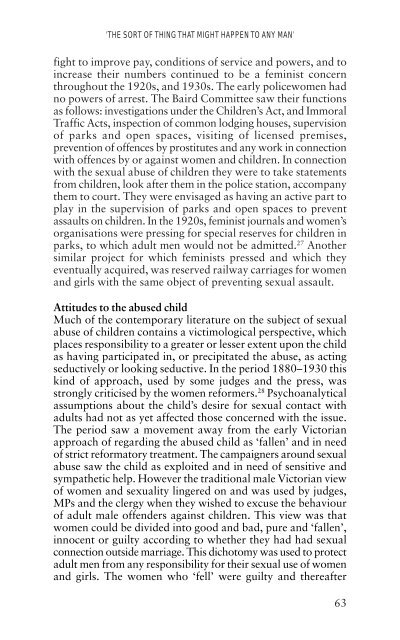The Spinster and Her Enemies - Feminish
The Spinster and Her Enemies - Feminish
The Spinster and Her Enemies - Feminish
Create successful ePaper yourself
Turn your PDF publications into a flip-book with our unique Google optimized e-Paper software.
‘THE SORT OF THING THAT MIGHT HAPPEN TO ANY MAN’<br />
fight to improve pay, conditions of service <strong>and</strong> powers, <strong>and</strong> to<br />
increase their numbers continued to be a feminist concern<br />
throughout the 1920s, <strong>and</strong> 1930s. <strong>The</strong> early policewomen had<br />
no powers of arrest. <strong>The</strong> Baird Committee saw their functions<br />
as follows: investigations under the Children’s Act, <strong>and</strong> Immoral<br />
Traffic Acts, inspection of common lodging houses, supervision<br />
of parks <strong>and</strong> open spaces, visiting of licensed premises,<br />
prevention of offences by prostitutes <strong>and</strong> any work in connection<br />
with offences by or against women <strong>and</strong> children. In connection<br />
with the sexual abuse of children they were to take statements<br />
from children, look after them in the police station, accompany<br />
them to court. <strong>The</strong>y were envisaged as having an active part to<br />
play in the supervision of parks <strong>and</strong> open spaces to prevent<br />
assaults on children. In the 1920s, feminist journals <strong>and</strong> women’s<br />
organisations were pressing for special reserves for children in<br />
parks, to which adult men would not be admitted. 27 Another<br />
similar project for which feminists pressed <strong>and</strong> which they<br />
eventually acquired, was reserved railway carriages for women<br />
<strong>and</strong> girls with the same object of preventing sexual assault.<br />
Attitudes to the abused child<br />
Much of the contemporary literature on the subject of sexual<br />
abuse of children contains a victimological perspective, which<br />
places responsibility to a greater or lesser extent upon the child<br />
as having participated in, or precipitated the abuse, as acting<br />
seductively or looking seductive. In the period 1880–1930 this<br />
kind of approach, used by some judges <strong>and</strong> the press, was<br />
strongly criticised by the women reformers. 28 Psychoanalytical<br />
assumptions about the child’s desire for sexual contact with<br />
adults had not as yet affected those concerned with the issue.<br />
<strong>The</strong> period saw a movement away from the early Victorian<br />
approach of regarding the abused child as ‘fallen’ <strong>and</strong> in need<br />
of strict reformatory treatment. <strong>The</strong> campaigners around sexual<br />
abuse saw the child as exploited <strong>and</strong> in need of sensitive <strong>and</strong><br />
sympathetic help. However the traditional male Victorian view<br />
of women <strong>and</strong> sexuality lingered on <strong>and</strong> was used by judges,<br />
MPs <strong>and</strong> the clergy when they wished to excuse the behaviour<br />
of adult male offenders against children. This view was that<br />
women could be divided into good <strong>and</strong> bad, pure <strong>and</strong> ‘fallen’,<br />
innocent or guilty according to whether they had had sexual<br />
connection outside marriage. This dichotomy was used to protect<br />
adult men from any responsibility for their sexual use of women<br />
<strong>and</strong> girls. <strong>The</strong> women who ‘fell’ were guilty <strong>and</strong> thereafter<br />
63

















